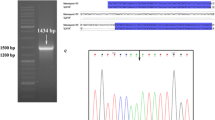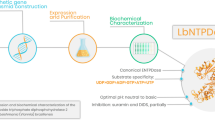Abstract
Tropical theileriosis is a disease caused by infection with an apicomplexan parasite, Theileria annulata, and giving rise to huge economic losses. In recent years, parasite resistance has been reported against the most effective antitheilerial drug used for the treatment of this disease. This emphasizes the need for alternative methods of treatment. Enolase is a key glycolytic enzyme and can be selected as a macromolecular target of therapy of tropical theileriosis. In this study, an intron sequence present in T. annulata enolase gene was removed by PCR-directed mutagenesis, and the gene was first cloned into pGEM-T Easy vector and then subcloned into pLATE31 vector, and expressed in Escherichia coli cells. The enzyme was purified by affinity chromatography using Ni–NTA agarose column. Steady-state kinetic parameters of the enzyme were determined using GraFit 3.0. High quantities (~65 mg/l of culture) of pure recombinant T. annulata enolase have been obtained in a higly purified form (>95 %). Homodimer form of purified protein was determined from the molecular weights obtained from a single band on SDS-PAGE (48 kDa) and from size exclusion chromatography (93 kDa). Enzyme kinetic measurements using 2-PGA as substrate gave a specific activity of ~40 U/mg, K m: 106 μM, kcat: 37 s−1, and k cat/K m: 3.5 × 105 M−1 s−1. These values have been determined for the first time from this parasite enzyme, and availability of large quantities of enolase enzyme will facilitate further kinetic and structural characterization toward design of new antitheilerial drugs.





Similar content being viewed by others
References
Mhadhbi, M., Naouach, A., Boumiza, A., Chaabani, M. F., BenAbderazzak, S., & Darghouth, M. A. (2010). In vivo evidence for the resistance of Theileria annulata to buparvaquone. Veterinary Parasitology, 169, 241–247.
Weir, W., Karagenç, T., Gharbi, M., Simuunza, M., Aypak, S., Aysul, N., et al. (2011). Population diversity and multiplicity of infection in Theileria annulata. International Journal for Parasitology, 41, 193–203.
Glass, E. J., Crutchley, S., & Jensen, K. (2012). Living with the enemy or uninvited guests: functional genomics approaches to investigating host resistance or tolerance traits to a protozoan parasite, Theileria annulata, in cattle. Veterinary Immunology and Immunopathology, 148, 178–189.
Witschi, M., Xia, D., Sanderson, S., Baumgartner, M., Wastling, J. M., & Dobbelaere, D. A. (2013). Proteomic analysis of the Theileria annulata schizont. International Journal for Parasitology, 43, 173–180.
Sharifiyazdi, H., Namazi, F., Oryan, A., Shahriari, R., & Razavi, M. (2012). Point mutations in the Theileria annulata cytochrome b gene is associated with buparvaquone treatment failure. Veterinary Parasitology, 187, 431–435.
Pal-Bhowmick, I., Sadagopan, K., Vora, H. K., Sehgal, A., Sharma, S., & Jarori, G. K. (2004). Cloning, over-expression, purification and characterization of Plasmodium falciparum enolase. European Journal of Biochemistry, 271, 4845–4854.
Kiama, T., Kiaira, J., Konji, V., & Musoke, A. (1999). Enzymes of glucose and glycerol catabolism in in vitro-propagated Theileria parva Schizonts. The Veterinary Journal, 158, 221–227.
Labbé, M., Péroval, M., Bourdieu, C., Girard-Misguich, F., & Péry, P. (2006). Eimeria tenella enolase and pyruvate kinase: a likely role in glycolysis and in others functions. International Journal for Parasitology, 36, 1443–1452.
Dzierszinski, F., Mortuaire, M., Dendouga, N., Popescu, O., & Tomavo, S. (2001). Differential expression of two plant-like enolases with distinct enzymatic and antigenic properties during stage conversion of the protozoan parasite Toxoplasma gondii. Journal of Molecular Biology, 309, 1017–1027.
Hannaert, V., Albert, M. A., Rigden, D. J., da Silva, Theresa, Giotto, M., Thiemann, O., et al. (2003). Kinetic characterization, structure modelling studies and crystallization of Trypanosoma brucei enolase. European Journal of Biochemistry, 270, 3205–3213.
Quiñones, W., Peña, P., Domingo-Sananes, M., Cáceres, A., Michels, P. A., Avilan, L., et al. (2007). Leishmania mexicana: molecular cloning and characterization of enolase. Experimental Parasitology, 116, 241–251.
Gandhi, N. S., Young, K., Warmington, J. R., & Mancera, R. L. (2008). Characterization of sequence and structural features of the Candida krusei enolase. In Silico Biology, 8, 449–460.
Han, K., Xu, L., Yan, R., Song, X., & Li, X. (2012). Molecular cloning, expression and characterization of enolase from adult Haemonchus contortus. Research in Veterinary Science, 92, 259–265.
Díaz-Martín, V., Manzano-Román, R., Oleaga, A., Encinas-Grandes, A., & Pérez-Sánchez, R. (2012). Cloning and characterization of a plasminogen-binding enolase from the saliva of the argasid tick Ornithodoros moubata. Veterinary Parasitology, 191, 301–314.
Liu, K. J., & Shih, N. Y. (2007). The role of enolase in tissue invasion and metastasis of pathogens and tumor cells. Journal of Cancer Molecules, 3, 45–48.
Turgut-Balik, D., Sadak, D., & Celik, V. (2006). Analysis of active site loop amino acids of enzyme lactate dehydrogenase from Plasmodium vivax by site-directed mutagenesis studies. Drug Development Research, 67, 175–180.
Laemmli, U. K. (1970). Cleavage of structural proteins during the assembly of the head of bacteriophage T4. Nature, 227, 680–685.
Grimsley, G. R., & Pace, C. N. (2003). Current protocols in protein science. Spectrophotometric determination of protein concentration. Hoboken, pp. 3.1.1–3.1.9.
Leatherbarrow, R. J. (1992). Grafit version 3.0, Erithacus Software Ltd., Staines.
Akat, A., Aktas, M., Dumanli, N., & Turgut-Balik, D. (2014). Isolation, cloning and sequence analysis of enolase enzyme encoding gene from Theileria annulata for assessment of important residues of this enzyme. Journal of Faculty Veterinary Medicine Kafkas University, 20, 243–248.
Albert, M. A., Haanstra, J. R., Hannaert, V., Van Roy, J., Opperdoes, F. R., Bakker, B. M., et al. (2005). Experimental and in silico analyses of glycolytic flux control in bloodstream form Trypanosoma brucei. Journal of Biological Chemistry, 280, 28306–28315.
Dunn, C. R., Banfield, M. J., Barker, J. J., Higham, C. W., Moreton, K. M., Turgut-Balik, D., et al. (1996). The structure of lactate dehydrogenase from Plasmodium falciparum reveals a new target for anti-malarial design. Natural Structural Biology, 3, 912–915.
Velanker, S. S., Ray, S. S., Gokhale, R. S., Balaram, H., Balaram, P., & Murthy, M. (1997). Triosephosphate isomerase from Plasmodium falciparum: the crystal structure provides insights into antimalarial drug design. Structure, 5, 751–761.
Chaikuad, A., Fairweather, V., Conners, R., Joseph-Horne, T., Turgut-Balik, D., & Brady, R. L. (2005). Structure of lactate dehydrogenase from Plasmodium vivax: complexes with NADH and APADH. Biochemistry, 44, 16221–16228.
Turgut-Balik, D., Shoemark, D. K., Moreton, K. M., Sessions, R. B., & Holbrook, J. J. (2001). Over-production of lactate dehydrogenase from Plasmodium falciparum opens a route to new antimalarials. Biotechnology Letters, 23, 917–921.
Shoemark, D. K., Cliff, M. J., Sessions, R. B., & Clarke, A. R. (2007). Enzymatic properties of the lactate dehydrogenase enzyme from Plasmodium falciparum. FEBS Journal, 274, 2738–2748.
Cameron, A., Read, J., Tranter, R., Winter, V. J., Sessions, R. B., Brady, R. L., et al. (2004). Identification and activity of a series of azole-based compounds with lactate dehydrogenase-directed anti-malarial activity. Journal of Biological Chemistry, 279, 31429–31439.
Pal-Bhowmick, I., Kumar, N., Sharma, S., Coppens, I., & Jarori, G. K. (2009). Plasmodium falciparum enolase: stage-specific expression and sub-cellular localization. Malaria Journal, 8, 1475–2875.
Kessler, O., Jiang, Y., & Chasin, L. (1993). Order of intron removal during splicing of endogenous adenine phosphoribosyltransferase and dihydrofolate reductase pre-mRNA. Molecular and Cellular Biology, 13, 6211–6222.
Kriangkum, J., Warkinton, A., Belch, A. R., & Pilarski, L. M. (2013). Alteration of introns in a hyaluronan synthase 1 (HAS1) minigene convert pre-mrna splicing to the aberrant pattern in multiple myeloma (MM): MM patients harbor similar changes. PLoS ONE, 8, e53469.
Ferguson, D. J., Parmley, S. F., & Tomavo, S. (2002). Evidence for nuclear localisation of two stage-specific isoenzymes of enolase in Toxoplasma gondii correlates with active parasite replication. International Journal for Parasitology, 32, 1399–1410.
Pal-Bhowmick, I., Vora, H. K., & Jarori, G. K. (2007). Sub-cellular localization and post-translational modifications of the Plasmodium yoelii enolase suggest moonlighting functions. Malaria Journal, 6, 45.
Maldonado, J., Marina, C., Puig, J., Maizo, Z., & Avilan, L. (2006). A study of cutaneous lesions caused by Leishmania mexicana in plasminogen-deficient mice. Experimental and Molecular Pathology, 80, 289–294.
Pal-Bhowmick, I., Mehta, M., Coppens, I., Sharma, S., & Jarori, G. K. (2007). Protective properties and surface localization of Plasmodium falciparum enolase. Infection and Immunity, 75, 5500–5508.
Acknowledgments
This project was supported by Yildiz Technical University Scientific Research Projects Coordination Department under the Project Number: 2011-0704-KAP03.
Author information
Authors and Affiliations
Corresponding author
Rights and permissions
About this article
Cite this article
Cayir, E., Erdemir, A., Ozkan, E. et al. Cloning of Intron-Removed Enolase Gene and Expression, Purification, Kinetic Characterization of the Enzyme from Theileria annulata . Mol Biotechnol 56, 689–696 (2014). https://doi.org/10.1007/s12033-014-9747-z
Published:
Issue Date:
DOI: https://doi.org/10.1007/s12033-014-9747-z




